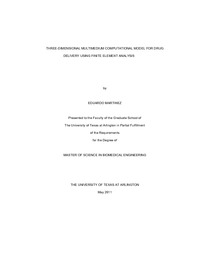
ATTENTION: The works hosted here are being migrated to a new repository that will consolidate resources, improve discoverability, and better show UTA's research impact on the global community. We will update authors as the migration progresses. Please see MavMatrix for more information.
Show simple item record
| dc.contributor.author | Martinez, Eduardo | en_US |
| dc.date.accessioned | 2011-07-14T20:53:40Z | |
| dc.date.available | 2011-07-14T20:53:40Z | |
| dc.date.issued | 2011-07-14 | |
| dc.date.submitted | January 2011 | en_US |
| dc.identifier.other | DISS-11045 | en_US |
| dc.identifier.uri | http://hdl.handle.net/10106/5822 | |
| dc.description.abstract | Approximately 2.8% of trauma patients present peripheral nerve injury, which can result in loss of motor function. Current strategies for peripheral nerve repair had focused on the development of synthetic nerve conduits that provide physical guidance. One advantage of the synthetic nerve conduits is that the conduit can be utilize as a delivery system and gain the ability to deliver neurotrophic factors, which have an effect on controlling the survival, migration, proliferation, and differentiation of different neural cell types. Currently there is no method to quantify the concentration of growth factors in the nerve conduit during the implantation time. In order to generate a spatiotemporal profile for the implantable rug delivery device, a complex multimedium model contemplating the release from polymers and diffusion in hydrogels, was developed. The model is based on two configurations of cylindrical nerve conduits that incorporated different hydrogels with and without the release from biodegradable polymer loaded microparticles. The hydrogel diffusion model was validated using published exact solutions for a cylinder and a sphere under perfect sink conditions. The calculated release profiles have a good agreement with the exact solutions with correlation coefficients of R2 = .995 for the cylinder and R2 = .996 for the sphere.The release model based on microparticles was compared with the measured release of Pleiotrophin (PTN) loaded 50/50 Poly (lactide-co-glycolide) (PLGA) microparticles, showing a correlation coefficient of R2 = .995. The model was implemented for a period of 30 days and produced spatiotemporal concentrations for the lumen of the modeled devices. Simulation of implantable drug delivery devices will contribute significantly to the development of tissue engineering, making possible the determination of the spatiotemporal concentrations of biomolecules that could not be determined otherwise. The control of microenvironments could lead to the improvement of the development of implantable scaffolds in the areas of angiogenesis, vascularization, and regeneration of nerve and bone, among others. | en_US |
| dc.description.sponsorship | Romero, Mario | en_US |
| dc.language.iso | en | en_US |
| dc.publisher | Biomedical Engineering | en_US |
| dc.title | Three-dimensional Multimedium Computational Model For Drug Delivery Using Finite Element Analysis | en_US |
| dc.type | M.Engr. | en_US |
| dc.contributor.committeeChair | Romero-Ortega, Mario | en_US |
| dc.degree.department | Biomedical Engineering | en_US |
| dc.degree.discipline | Biomedical Engineering | en_US |
| dc.degree.grantor | University of Texas at Arlington | en_US |
| dc.degree.level | masters | en_US |
| dc.degree.name | M.Engr. | en_US |
Files in this item
- Name:
- Martinez_uta_2502M_11045.pdf
- Size:
- 18.07Mb
- Format:
- PDF
This item appears in the following Collection(s)
Show simple item record


